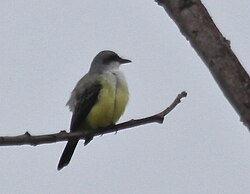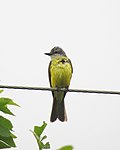Kingbird
The kingbird (Tyrannus melancholicus) is a large tyrant flycatcher. This bird breeds from southern Arizona in the United States to as far as south as central Argentina, western Peru, and Trinidad and Tobago. Birds from the northernmost and southern breeding areas migrate to warmer parts of the range after breeding.
| Kingbird | |
|---|---|

| |
| T. m. melancholicus The Pantanal, Brazil | |
| Conservation status | |
| Scientific classification | |
| Unrecognized taxon (fix): | Tyrannus |
| Species: | Template:Taxonomy/TyrannusT. melancholicus
|
| Binomial name | |
| Tyrannus melancholicus Vieillot, 1819
| |

| |
| Purple = year-round range; orange = breeding range | |
Description and ecology
An adult tropical kingbird is 22 cm (8.7 in) long and weighs 39 g (1.4 oz). Both male and female are similar, but young birds have pale buff edges on the wing coverts.
The call is a high-pitched twittering trill, tree-e-e-e-e-e-e, with a more complex version sung by the male at dawn.
Their breeding habitat is semi-open areas with trees and shrubs, including gardens and roadsides. Tropical kingbirds like to view their surroundings from an open perch, usually high in a tree. They take long flights to catch insects in mid-air, which is called hawking. They sometimes hover to pick food off of plants, which is called gleaning.[2][3] They also eat some fruit.[3][4]
These birds defend their territory against intruders, even much larger birds such as toucans, caracaras or hawks.
They make a flimsy cup nest in a tree. The eggs are cream-colored with reddish-brown marks. The female incubates the typical clutch of two or three eggs for 16 days. After they hatch, it is about 18–19 more days until fledging.
The tropical kingbird is not a threatened species of the IUCN.[1] This is because this bird is very common and they adapt well to changes in their environment.
T. m. satrapa, Panama
Kingbird Media
References
- ↑ 1.0 1.1 BirdLife International (2016). "Tyrannus melancholicus". IUCN Red List of Threatened Species. IUCN. 2016: e.T22700485A93779037. Retrieved 2 January 2020.
- ↑ de A. Gabriel, Vagner & Pizo, Marco A. (2005): Foraging behavior of tyrant flycatchers (Aves, Tyrannidae) in Brazil. Revista Brasileira de Zoologia 22 (4): 1072–1077 [English with Portuguese abstract]. PDF fulltext
- ↑ 3.0 3.1 Pascotto, Márcia Cristina (2006): Avifauna dispersora de sementes de Alchornea glandulosa (Euphorbiaceae) em uma área de mata ciliar no estado de São Paulo [Seed dispersal of Alchornea glandulosa (Euphorbiaceae) by birds in a gallery forest in São Paulo, southeastern Brazil.]. Revista Brasileira de Ornitologia 14 (3): 291–296 [Portuguese with English abstract]. PDF fulltext Archived 2010-11-02 at the Wayback Machine
- ↑ Foster, Mercedes S. (2007): The potential of fruiting trees to enhance converted habitats for migrating birds in southern Mexico. Bird Conservation International 17 (1): 45–61.
Other websites
| Wikimedia Commons has media related to Lua error in Module:Commons_link at line 62: attempt to index field 'wikibase' (a nil value).. |
| Wikispecies has information on: Tyrannus melancholicus. |
- Nesting Tyrannus melancholicus[1]












